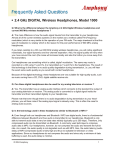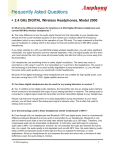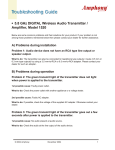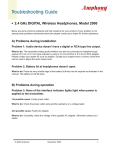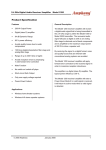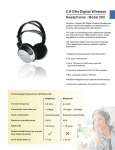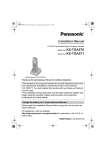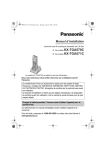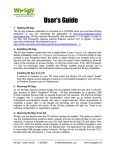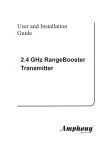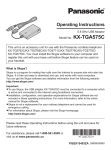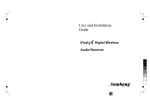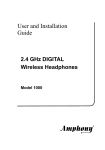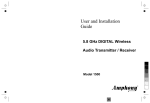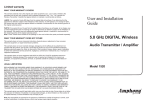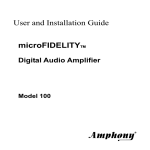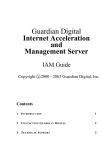Download Amphony 1550 User's Manual
Transcript
R Frequently Asked Questions 5.8 GHz DIGITAL Wireless Audio Transmitter / Amplifier, Model 1550 Q: What is the difference between the Amphony 5.8 GHz Digital Wireless Audio Transmitter / Amplifier and current 900 MHz or 2.4 GHz analog audio transmitters ? A: There are 3 major differences: 1) Digital transmission: The first difference is how the audio signal travels from the transmitter to the receiver. Almost all of the current wireless systems on the market use a method called FM (Frequency modulation) which is very similar to the operation of your FM radio. The major drawback ist that this type of modulation is ‘analog’ which is the reason for the poor performance of analog transmitters. If you listen carefully to a CD over an analog wireless audio transmitter / amplifier, you will notice significant noise/static, low signal dynamics and low channel separation. Also, the signal quality will vary when you move around the room between the transmitter and receiver (the noise will increase locally and also the further the receiver is moved away from the transmitter). The transmitter uses something which is called ‚digital' modulation. The same way music is recorded on a CD using 1's and 0's, it is transmitted as 1's and 0's to the headphones. The result of this technology is that there is no audio quality degradation during transmission, i.e. you will hear the exact same audio quality as you would if the equipment was connected by a cord. Because of this digital technology, our transmitter / amplifier is very suitable for high-quality audio, such as music coming from a CD, DVD, digital satellite receiver etc. 2) Transmitter frequency: The second difference is the higher transmit frequency of 5.8 GHz. This frequency avoids possible interference from other appliances working either in the 900 MHz or 2.4 GHz range, such as cordless telephones or wireless LANs. 3) Built-in digital amplifier: The receiver features a built-in audio amplifier and can be connected directly to any regular loudspeakers without an additional amplifier. This amplifier is a digital amplifier which reduces the amount of heat which is generated due to the high efficiency of the amplifier. Therefore the size and weight of the amplifier is greatly reduced compared to conventional analog audio amplifiers. By using a feedback mechanism, the harmonic distortion performance of the amplifier equals or exceeds the performance of conventional analog audio amplifiers. Q: Can the amplifier connect to loudspeakers ? A: Yes, the amplifiers each provide a speaker output and connect directly to regular loudspeakers. © 2004 Amphony 1 Q: How does the transmitter connect to my audio equipment? A: The transmitter connects to any standard audio line output via the supplied stereo RCA audio cable or to any standard amplified speaker output via the supplied speaker cable. The transmitter can also be connected to other audio outputs, such as headphone outputs, by using an appropriate adapter. The transmitter can be adjusted to the audio level provided by the audio source via a transmitter volume control. Q: Does the transmitter connect to the amplified speaker output of my surround sound receiver? A: Yes, the transmitter can be connected directly to an amplified speaker output. Q: Is the technology used similar to Bluetooth or MP3? A: Even though both our transmitter / amplifier and Bluetooth / MP3 use digital audio, there is a fundamental difference between Bluetooth and how audio is transmitted by our transmitter. Bluetooth is only able to transmit audio data at very low data rates reliably (typically up to 200 kbps). Therefore, only compressed audio can be transmitted via Bluetooth. A commonly used technique to compress audio data is MP3. Our transmitter, however, does not compress the audio and transmits the full bit rate. As a result, the audio quality is not degraded such as with MP3. Also, the audio latency (audio delay) of MP3 compressed audio is fairly high and thus not suitable for television or surround sound applications. Since our transmitter does not compress the audio and since only a minimum of data buffering is used, the audio delay is minimal. Q: What is Forward Error Correction and why is it used by the transmitter / amplifier ? A: Occasionally, there may be some data which is corrupted during transmission. This may be the case when there is interference, such as other transmitters, electrical sparks or if you move around and the signal is temporarily lost. Forward Error Correction as it is used by the transmitter / receiver can in most cases repair the data which is received to guarantee 100% correct data reception and therefore 100% correct audio reception. This technology is in part responsible for the high robustness of the transmission. With analog audio transmitters you may have noticed ‘clicks’ or ‘pops’ during sparks which often occur when switching on appliances. Q: Can this transmitter / amplifier be used to transmit surround sound to rear speakers ? A: Yes. In this case the transmitter needs to be connected to the two rear speaker channels of your surround-sound decoder. You can either use a line-level audio output if available or an amplified speaker ouput. Both outputs can be connected directly to the transmitter. © 2004 Amphony 2 Q: Do I need line of sight between the transmitter and amplifier ? A: Line of sight between the transmitter and amplifier is preferred but not necessary for the amplifier to operate. However, for maximum reliability, we recommend that the amplifier be placed such that the number of walls of obstacles between the transmitter and amplifier is reduced to a minimum. Q: How many channels of audio can I transmit ? A: The transmitter transmits up to 2 channels of audio (stereo). Q: How do I change the volume of the speakers connected to the amplifier ? A: The volume of the speakers is mainly controlled by the volume which is fed into the transmitter. The amplifier features a volume control which is set once during installation to control the maximum volume at the speakers. This setting will depend on your room size and type of speakers. In a surround sound application, this volume control will be set such that the speakers connected to the amplifier are balanced with the other speakers. The transmitter also incorporates a volume control to set the transmitter to the audio level of your audio source. This transmitter volume control affects both the line and speaker audio input. Q: Does the transmitter accept digital audio data ? A: The Model 1520 transmitter does not connect to digital audio sources. Q: Can I use multiple amplifiers at the same time ? A: An unlimited number of amplifiers can be used that operate from the same transmitter. For example, you can operate two seperate amplifiers to connect two speakers which are located apart from each other. Each speaker connects to one of the two audio outputs of the amplifier. The other audio output of each amplifier is not used in this case. Q: Can I operate multiple transmitters in the same room, all of which receive audio from different sources ? A: While it is possible to connect multiple transmitters to different audio sources in the same room, only one transmitter can be active at a time. However, it is possible to operate a 5.8 GHz transmitter at the same time as a 2.4 GHz transmitter without any conflicts. Q: Does the amplifier work with the Model 2500 headphone transmitter ? A: The amplifier is not compatible with the Model 2500 headphone transmitter. © 2004 Amphony 3 Q: What are the benefits of transmitting the full data rate without using audio compression ? A: Since our transmitter transmits a data rate of over 3 Mbps (3 million bits per second), the audio can be transmitted without audio compression. Also, forward error correction can be used. The reason that other systems use audio compression is to reduce the extremely high data rate of a pure (uncompressed) audio signal in order to either be able to store that signal or transmit that signal more easily. The biggest drawback of using audio compression is that the quality of the audio signal is reduced, such as in MP3-compressed audio. This is because audio compression removes parts of the music. Some types of music which are particularly difficult to compress without noticing audio degradation. Systems using audio compression are not able to deliver CD-quality audio. Q: Will my 2.4 GHz cordless telephone or wireless LAN affect the operation of the transmitter / amplifier or vice versa ? A: Wireless LANs typically work at 2.4 GHz and will not affect the operation of the amplifier, nor will any 2.4 GHz cordless phones or Bluetooth devices. However, some 5.8 GHz cordless phones may cause the amplifier to mute. The range of the transmitter may also be affected during the operation of other 5.8 GHz equipment. If you do operate a 5.8 GHz cordless telephone, we recommend that you purchase our 2.4 GHz transmitter / receiver to eliminate any possibility of interference. Whether or not the amplifier will be affected by other 5.8 GHz devices depends to a large degree on the type of equipment and the distance between such equipment and the amplifier relative to the audio transmitter. Digital cordless telephones are more likely to cause problems than analog cordless telephones. The base station of certain types of cordless telephones, such as the Panasonic Gigarange series, will periodically broadcast signal beacons, even when the telephone is not in use, that may cause a clicking noise of the amplifier. Walls located between such equipment and the amplifier will in many cases attenuate an interfering signal enough for it not to cause any problems when operating the amplifier. The amplifier employs an error correction scheme and thus can tolerate interference up to a certain degree without any signal degradation. If interference is a problem and if there is no direct line-of-sight to the audio transmitter then we recommend the use of the Model 1550 transmitter which transmits a stronger signal than the Model 1520 transmitter.. Q: What does the noise shaping filter do which is part of the amplifier ? A: Digital audio, such as audio on a CD and the audio transmitted to the amplifier, is represented by numbers that represent voltage levels. When analog audio is converted to digital audio, the voltage of the audio signal is sampled and represented by a number that refers to the voltage that comes closest to the actual voltage. Because there is usually a small difference between that voltage and the actual voltage of the analog audio signal, a certain amount of noise - quantization noise - is introduced. The amount of such quantization noise is, among other things, determined by the amount of information that is used to represent each sample - resolution. Therefore, digital audio on a CD and audio transmitted to the receiver always contains a small amount of quantization noise which limits the maximum possible signal-to-noise ratio of the transmission. In order to increase the signal-to-noise ration beyond that limit, the receiver features a special noise shaping filter which is a 5th-order filter that outputs the audio at 64 times the sampling frequency and shifts the audio data quantization noise to higher frequencies that are outside of the audible frequency band. As a result, the amplifier is able to achieve a higher signal-to-noise ratio than would be possible without a noise shaping filter. © 2004 Amphony 4 Contacting Amphony S upport For contact details and Local Sales Representatives, visit the Amphony web site at: http://www.amphony.com Amphony has made best efforts to ensure that the information contained in this document is accurate and reliable. However, t he information is subject to change without notice and is provided “AS IS” without warranty of any kind (express or implied). No responsibility is assumed by Amphony for the use of this information, nor for infringements of patents or other rights of third parties. This document is the property of Amphony and implies no license under patents, copyrights, trademarks, or trade secrets. No part of this publication may be used as a basis for manufacture or sale of any items without the prior written consent of Amphony. The names of products of Amphony or other vendors and suppliers appearing in this document may be trademarks or service marks of their respective owners which may be registered in some jurisdictions. A list of Amphony trademarks and service marks can be found at http://www.amphony.com. © 2004 Amphony 5





